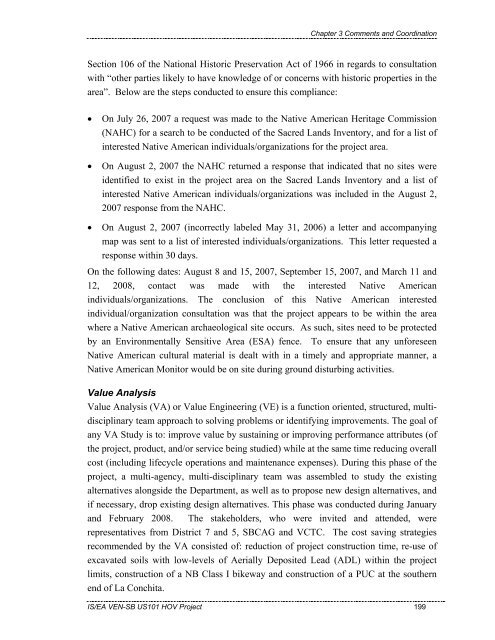Chapter 1 - Caltrans - State of California
Chapter 1 - Caltrans - State of California
Chapter 1 - Caltrans - State of California
You also want an ePaper? Increase the reach of your titles
YUMPU automatically turns print PDFs into web optimized ePapers that Google loves.
<strong>Chapter</strong> 3 Comments and Coordination<br />
Section 106 <strong>of</strong> the National Historic Preservation Act <strong>of</strong> 1966 in regards to consultation<br />
with “other parties likely to have knowledge <strong>of</strong> or concerns with historic properties in the<br />
area”. Below are the steps conducted to ensure this compliance:<br />
• On July 26, 2007 a request was made to the Native American Heritage Commission<br />
(NAHC) for a search to be conducted <strong>of</strong> the Sacred Lands Inventory, and for a list <strong>of</strong><br />
interested Native American individuals/organizations for the project area.<br />
• On August 2, 2007 the NAHC returned a response that indicated that no sites were<br />
identified to exist in the project area on the Sacred Lands Inventory and a list <strong>of</strong><br />
interested Native American individuals/organizations was included in the August 2,<br />
2007 response from the NAHC.<br />
• On August 2, 2007 (incorrectly labeled May 31, 2006) a letter and accompanying<br />
map was sent to a list <strong>of</strong> interested individuals/organizations. This letter requested a<br />
response within 30 days.<br />
On the following dates: August 8 and 15, 2007, September 15, 2007, and March 11 and<br />
12, 2008, contact was made with the interested Native American<br />
individuals/organizations. The conclusion <strong>of</strong> this Native American interested<br />
individual/organization consultation was that the project appears to be within the area<br />
where a Native American archaeological site occurs. As such, sites need to be protected<br />
by an Environmentally Sensitive Area (ESA) fence. To ensure that any unforeseen<br />
Native American cultural material is dealt with in a timely and appropriate manner, a<br />
Native American Monitor would be on site during ground disturbing activities.<br />
Value Analysis<br />
Value Analysis (VA) or Value Engineering (VE) is a function oriented, structured, multidisciplinary<br />
team approach to solving problems or identifying improvements. The goal <strong>of</strong><br />
any VA Study is to: improve value by sustaining or improving performance attributes (<strong>of</strong><br />
the project, product, and/or service being studied) while at the same time reducing overall<br />
cost (including lifecycle operations and maintenance expenses). During this phase <strong>of</strong> the<br />
project, a multi-agency, multi-disciplinary team was assembled to study the existing<br />
alternatives alongside the Department, as well as to propose new design alternatives, and<br />
if necessary, drop existing design alternatives. This phase was conducted during January<br />
and February 2008. The stakeholders, who were invited and attended, were<br />
representatives from District 7 and 5, SBCAG and VCTC. The cost saving strategies<br />
recommended by the VA consisted <strong>of</strong>: reduction <strong>of</strong> project construction time, re-use <strong>of</strong><br />
excavated soils with low-levels <strong>of</strong> Aerially Deposited Lead (ADL) within the project<br />
limits, construction <strong>of</strong> a NB Class I bikeway and construction <strong>of</strong> a PUC at the southern<br />
end <strong>of</strong> La Conchita.<br />
IS/EA VEN-SB US101 HOV Project 199

















